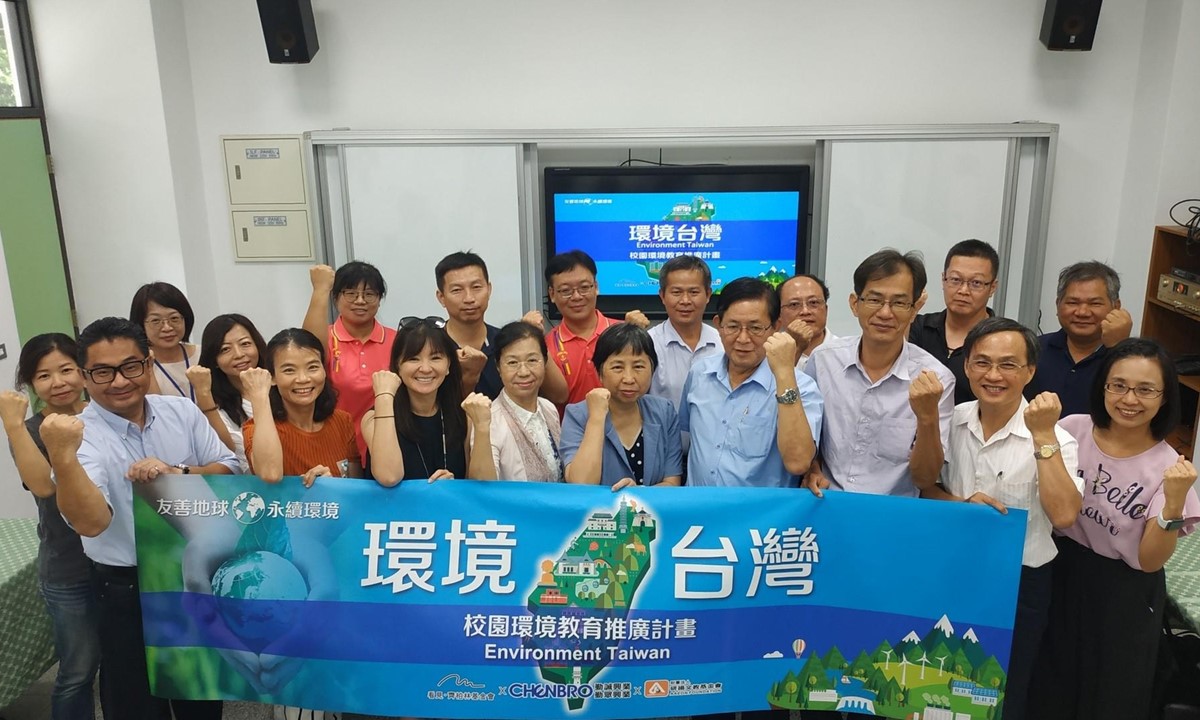
Telling stories through images, and helping children first “see” and subsequently build a sense of connection with the land under their feet, is one of the best approaches to environmental education. Chi Po-lin’s Beyond Beauty – TAIWAN FROM ABOVE and the aerial images accumulated over the course of twenty-five years have indeed carried out such a role. Therefore, since the establishment of the Chi Po-lin Foundation, one of our vital missions has been to facilitate environmental education to take deeper root.
Environmental education has received more and more attention in Taiwan in recent years. The government has not only stipulated basic lesson hours, but also demanded that environmental education must be incorporated into every subject. However, environmental education is itself an encompassing cosmos, and it is relatively strenuous for teachers of different subjects to quickly carry out the integration of course materials of all the subjects. As a result, the Foundation has combined various image resources to design a range of lesson plans to hopefully become schoolteachers’ best partner in imparting environmental knowledge.
In addition to combining field trips and school tours of Beyond Beauty public screenings and thematic talks, the Foundation has spent a year to plan and prepare the education project, “Environment Taiwan,” which comprises exhibitions, developing course materials, public screenings and talks, learning tours, and picture book competitions. In September 2021, when the new semester began, five schools in Yunlin County, namely Dadong, Liren, Guilin, Bliss Wisdom, and Zhanghu elementary schools have entered a two-semester process of deep cultivation to foster a fertile ground that will enable environmental education to flourish.
Five Thematic Lesson Plans – Mountains, Rivers, Ocean, Cities, Townships
Teaching comprises a series of meticulously designed teacher-student interaction, with the objective to encourage students to explore actively. The aerial images rely on teachers to help children navigate environmental issues embedded therein. Consequently, suitable images, professional environmental education, practical course materials, as well as the budget and mechanism of communication and collaboration are all quintessential factors.
With the support of Chenbro and Chen-Source, “Environment Taiwan” collaborates with the Aaeon Foundation, and introduces the concept of “modular manufacturing” into promoting environmental education: The Chi Po-lin Foundation first curates exhibitions based on five major themes – “mountains, rivers, ocean, cities, townships,” and then invites five elementary schools to each claim one to develop lesson plans for students of lower grade, intermediate grade, and higher grade respectively. Thus, the schools help students build prior knowledge and explorative motivations before viewing the exhibitions.
Audiovisual stimulations can better pique children’s curiosity and interest. So, the course plans are designed as slide shows, combined with diverse digital materials such as videos, pictures, and animations. For example, Bliss Wisdom Elementary School has developed its course plan, titled “Coastal Train,” which utilizes Chi’s images of Green Bay (or Feitsui Bay), Gaomei Wetland, coral reefs in Kenting, and Qingshui Cliff, making use of the aerial perspective and enabling children to view panoramically the coastal features in northern, central, southern, and eastern Taiwan.
The Foundation’s image resources and knowledge of environmental education, combined with schoolteachers’ profession of teaching, as well as the Aaeon Foundation’s years of experience in developing “modularized digital course materials,” allow us to reproduce efficiently lesson plans of environmental education in different schools. Through forming such an alliance, division of labor, and the approach of modularization, we can now not just expand widely children’s horizon, but also enable teachers to reap five times the reward in terms of the effort they put into preparing the classes and reserving their energy for guiding and interacting with students.

Diverse Interaction to Open Children’s Minds and Eyes
After the semester begins in September, the five environment-centered lesson plans will take turns to be demonstrated in the five elementary schools in five consecutive months. According to Wang Wen-Liang, a teacher at Liren Elementary School, one of the five schools in the alliance, the greatest challenging in environmental education has been to use diversified approaches to arouse children’s interest in caring about the environment so that they would be willing to put necessary changes into practice in everyday life. “Environment Taiwan” utilizes digital course materials to give children prior knowledge, and then uses thematic exhibitions, public screenings, and related talks to engage children in seeing Taiwan. Meanwhile, students of higher grade will be serving as environmental education ambassadors. So, he very much looks forward to seeing the teaching results of such diverse interaction.
Furthermore, the project also includes learning tours and picture book competitions in a later stage. Environmental ambassadors who perform well in their role will visit the Chi Po-lin Museum, where they can see more brilliant photographic works, and more profoundly perceive the spirit of Chi Po-lin. Afterwards, they can put what they have learned into the creation of picture books, with which they can share what they have seen and heard during the tour of environmental education with the entire schools.
From an educational point of view, Chi’s aerial photography is aesthetically, intellectually, and environmentally inspiring. Through the composition informed by the beauty of light and shadow, children are guided to observe the beautiful and grim aspects in the environment. In addition, through comparing documented landscape from different times with major environmental changes discussed in textbook, children’s horizon is elevated to a level that surpasses enclosed classrooms and urban regions, which enables them to feel for the land and nature. When children start to pay attention to the environment, there is a brighter hope for Taiwan of the next generation.
With a corporate zest to give back to the homeland, “Environment Taiwan” now takes the first step in Yunlin County with the support of Chenbro and Chen-Source. In the future, we hope more corporations could join us to spread the teaching modules of “Environment Taiwan” to more cities, counties, and elementary schools so that Taiwan’s environmental education could take deeper and firmer root.